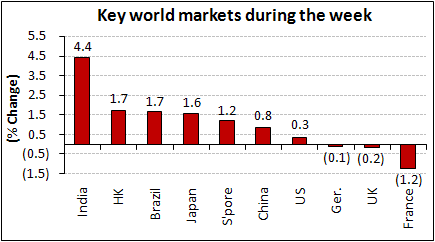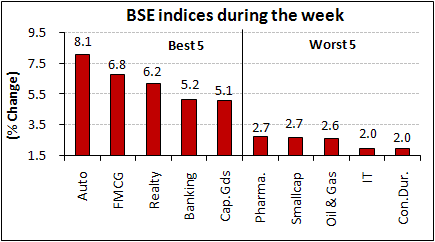India's Third Giant Leap
This Could be One of the Biggest Opportunities for Investors
- Home
- Todays Market
- Indian Stock Market News March 5, 2011
Fiscal roadmap cheer markets Sat, 5 Mar RoundUp
The world markets depicted mixed performance during the week. While emerging markets closed the week on a strong footing developed markets displayed a weak performance with the exception of Japan and US. Amongst the developed markets the biggest loser was France (down 1.2%) followed by UK and Germany. However, the US and Japan registered marginal gains of 0.3% and 1.6% respectively during the week. The developed markets were more or less steady for the week ahead of the eagerly anticipated key employment report from the US. However, tensions emanating from the Middle East and possibility of surge in oil prices continue to somber investor’s sentiments.
Amongst emerging markets, India was the biggest gainer (up 4.4%) closely followed by Hong Kong and Brazil. Singapore and China too registered modest gains of 1.2% and 0.8% respectively. The fiscal road map laid down by the Finance Minister during the course of the budget announcement lead to a sharp rally in the Indian markets.
 |
| Source: Yahoo Finance |
Moving on to the performance of sectoral indices in India, predictably all indices closed the week in the green. The biggest gainer of the week was BSE-Auto index (up 8.1%) along with BSE-FMCG index (up 6.8%) as the excise duties remained unchanged on auto and tobacco products. BSE-Realty index and BSE-Banking index too registered a strong performance and were up 6.2% and 5.2% respectively. Extension of interest rate subsidy on affordable housing and further recapitalization of PSU banks fuelled rally in both the sectors. However, Consumer durable index and the IT index registered modest gains of 2.0% each during the week.
 |
| Source: BSE |
Moving on to key corporate/economic developments, the Union Budget 2011 was announced during the week. We will discuss the key highlights of the same here.
While on the reforms front the budget was neutral, the fiscal road map laid down by the finance minister was well received by the market. The Finance Minister in his speech stated that the fiscal deficit was down to 5.1% of GDP for FY11 (the last Budget had put the figure at 5.5%). For FY12, FY13 and FY14, the targets have been set at 4.6%, 4.1% and 3.5%. The positive is that the government acknowledges the importance of bringing the fiscal deficit down so that there is more headroom to spend on critical areas such as education, infrastructure and healthcare. However, it will be interesting to see how it manages to do so in an environment of high fuel prices. That said, although the target does look ambitious, this itself can bring about a significant downward pressure on interest rates if achieved.
The two sectors on which an increasing thrust was laid during the latest budget were infrastructureand banking. As far as the infrastructure sector is concerned, the finance minister made a couple of interesting suggestions that should ease the flow of credit into the sector. The investment limit by FIIs in the corporate infra bonds has been raised by US$ 25 bn, taking the total limit available for foreign investors to US$ 40 bn. There was also a recommendation to allow selective government agencies to issue tax free infrastructure bonds to the tune of Rs 300 bn. This should ease credit concerns for the cash starved sector. Further, tax benefit for investing in infrastructure bonds for individuals (to the tune of Rs 20,000 - above the investment limit of Rs 1 lac) stays put and is extended by another year. Disbursement targets for IIFCL were also raised while withholding tax on notified infra funds was also reduced. Most of the suggestions were aimed at reducing the liquidity constraints plaguing the sector right now.
As far as banking goes the FM was confident that RBI will come out with guidelines regarding the issuance of additional banking licences (announced in the last budget) before 31 March 2011. Further a sum of Rs 60 bn will be offered to undercapitalized PSU banks to attain the minimum tier-1 capital ratio by FY12. An additional interest subvention of 1% was provided on farm loans taking the effective rate to about 4%. Suggestions were also made to create a Microfinance Equity Fund to protect the interest of the small borrowers.
Now moving on from budget to the key corporate developments that happened during the week. Oil marketing firms such as IOC, BPCL and HPCL have laid a proposal to raise petrol prices by up to Rs 4 per litre. This move is aimed at offsetting rising crude oil costs. The Union Budget 2011-12 had ignored their demand to cut duties on the fuel. The excise duty, a central levy on domestic production on petrol, is Rs 14.35 a litre. It may be noted that the government had deregulated petrol prices in June last year. Nonetheless, the three state-run oil companies informally consult the ministry before revising petrol rates. Oil companies are currently losing Rs 10.7 a litre on diesel, Rs 21.6 a litre on kerosene and Rs 356 on an LPG cylinder. Deregulating the fuel prices will not only help the bleeding oil companies but will also plug the fiscal deficit as the subsidy burden would come down.
Meanwhile, most of auto companies’ announced their figures for the month of February and the numbers were encouraging. Auto sales have benefitted from the introduction of new vehicles, easier availability of loans and higher personal incomes. Moreover, the February sales were higher also because customers advanced purchases on the expectation that prices would increase in March. It may be noted that the auto industry was expecting the government to raise excise tax in the Union Budget 2011-12. But the tax was left unchanged at 10%.
| Company | 25-Feb-10 | 04-Mar-11 | Change | 52-wk High/Low | |
| Top gainers during the week (BSE-A Group) | |||||
| Ashok Leyland | 47 | 54 | 14.8% | 82/47 | |
| ITC Ltd | 153 | 173 | 12.8% | 185/123 | |
| P&G Hygiene | 1,511 | 1,695 | 12.2% | 2372/1475 | |
| IVRCL Infrastructures | 66 | 74 | 11.8% | 194/63 | |
| Gujarat NRE Coke | 43 | 47 | 11.5% | 85/42 | |
| Top losers during the week (BSE-A Group) | |||||
| Mphasis Ltd | 550 | 454 | -17.5% | 712/355 | |
| Reliance Infra | 675 | 607 | -10.1% | 1225/555 | |
| Mundra Port & SEZ | 146 | 133 | -8.8% | 185/128 | |
| Sterling Biotech | 106 | 98 | -7.3% | 126/97 | |
| Tata Communications | 226 | 212 | -6.0% | 354/195 | |
Telecom regulator, TRAI has announced the subscriber numbers for the month of January. The wireless subscriber base grew 2.5% to 771 m in January, taking the total (fixed and mobile) telecom subscriber base to 806 m. However, it may be noted that of the total 771 m subscribers only 548 m were active subscribers. The overall tele-density stands at 67% with the share of urban subscribers at 66% and that of the rural subscribers at 34%. The overall growth was led by Bharti Airtel which added 3.3 m users taking it total subscriber base to 156 m. RCOM followed next with adding 3.2 m subscribers, taking its user base to 127 m subscribers. However, the performance of new operators was dismal as their subscriber base has been declining continuously. As far as the broadband subscriber base is concerned, it increased marginally in January 2011 to 11.2 m (from 10.7 m in December 2010).
Recently the government sought an additional sanction of Rs 795 bn in order to meet expenses related to oil and fertilizer subsidies. This amount is over and above the funds allocated earlier for the subsidy bill. Out of the total proposed amount, Rs 210 bn will be used for compensating OMCs for under-recoveries while Rs 90 bn will be used for meeting the defense bill and Rs 80 bn towards fertilizer subsidies. It may be noted that in the light of rising crude oil prices and increasing food inflation subsidy burden has widened creating fiscal imbalances. As highlighted earlier, the government has a laid down an aggressive road map for reducing fiscal deficit over the next few years. However, with rising crude prices and food inflation it is interesting to see whether the plan actually materializes. De-controlling diesel prices could be one of the options to reduce the subsidy burden and bridge the fiscal deficit. But it is interesting to see whether the government will bite the bullet as decontrol would mean a further rise in inflation.
For information on how to pick stocks that have the potential to deliver big returns, download our special report now!
Read the latest Market Commentary


Equitymaster requests your view! Post a comment on "Fiscal roadmap cheer markets". Click here!
Comments are moderated by Equitymaster, in accordance with the Terms of Use, and may not appear
on this article until they have been reviewed and deemed appropriate for posting.
In the meantime, you may want to share this article with your friends!